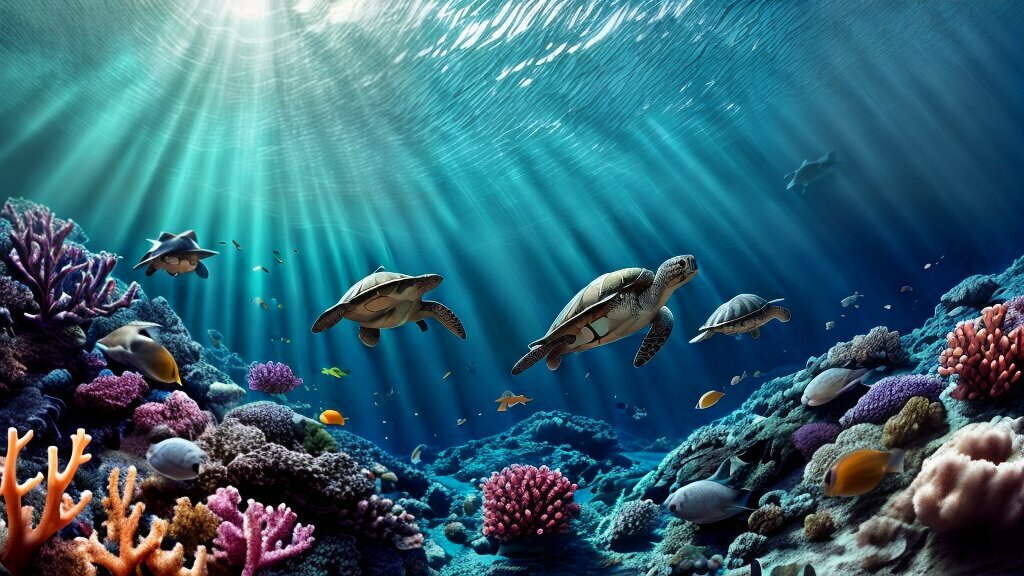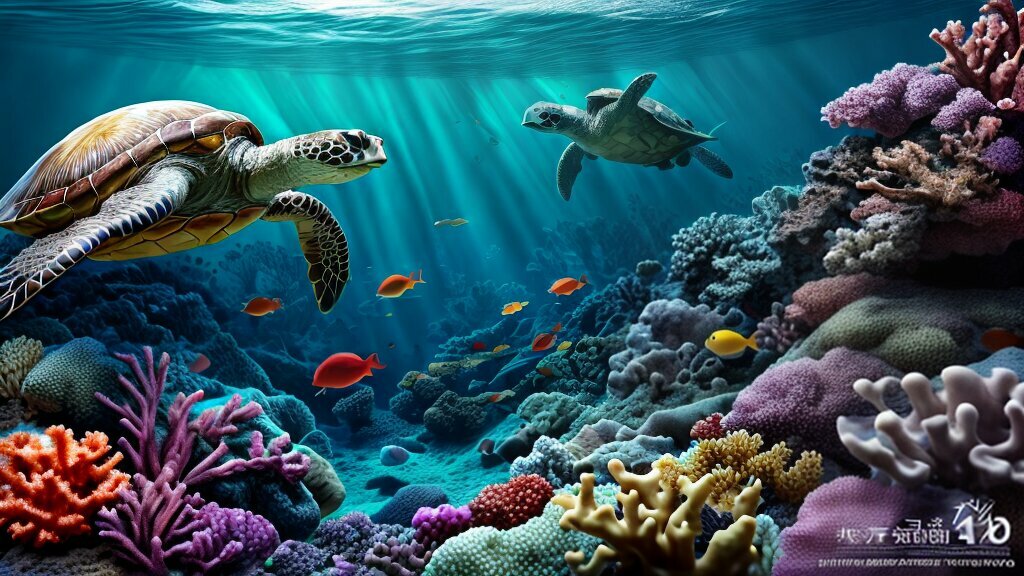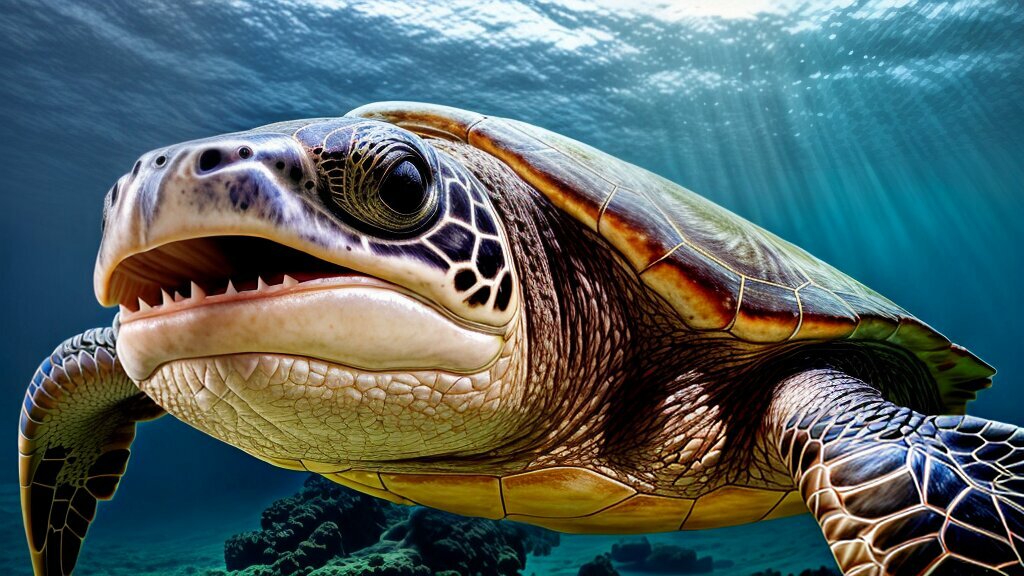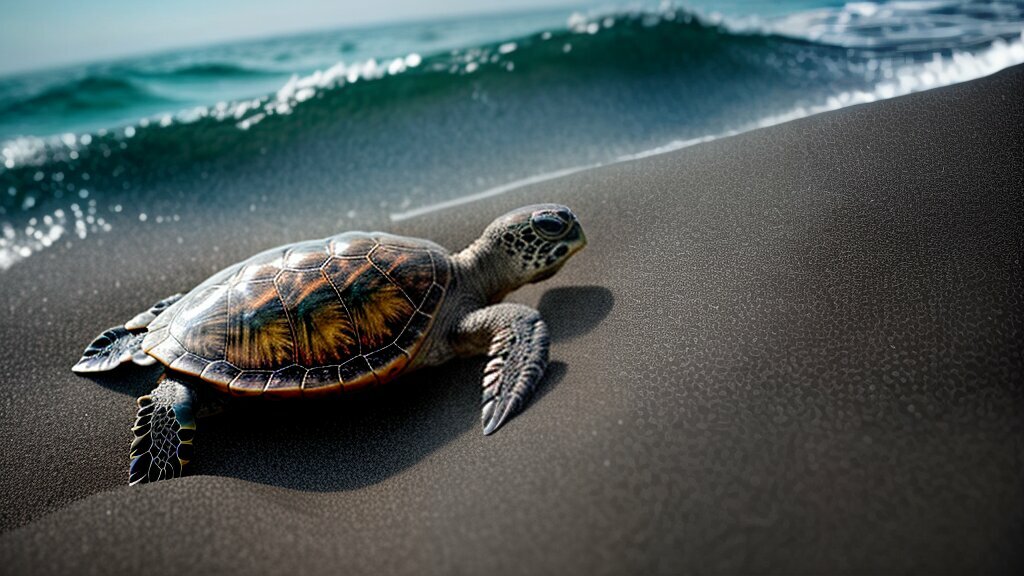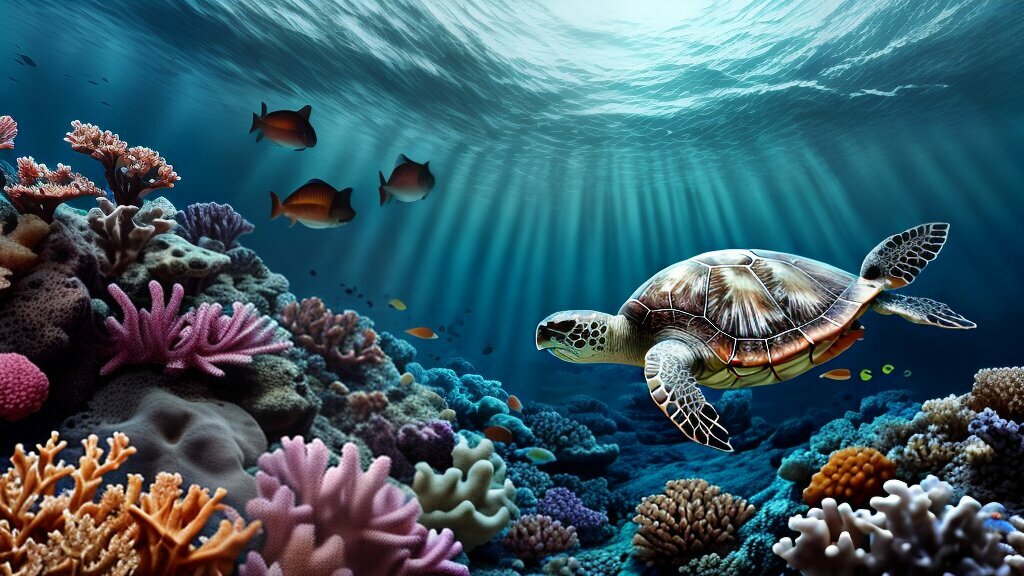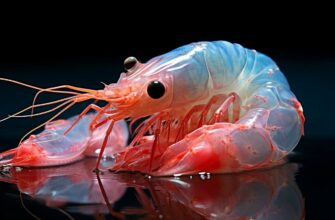Have you ever wondered if sea turtles bite? These majestic creatures can be found in oceans around the world and are often a highlight for snorkelers and divers. However, it’s important to understand their behavior to stay safe around them. In this article, we will explore whether sea turtles bite, their behavior in general, and how to prevent bites.
- Key Takeaways:
- Understanding Sea Turtle Behavior
- Interactions with Humans
- Conservation Efforts
- Do Sea Turtles Bite? Exploring Biting Behavior
- Types of Sea Turtles and their Biting Tendencies
- Understanding Sea Turtle Bite Force and Marks
- Preventing Sea Turtle Bites
- Sea Turtle Bites: Facts and Cases
- Conclusion
- FAQ
- Q: Do sea turtles bite?
- Q: What is sea turtle behavior like?
- Q: When do sea turtles bite?
- Q: Do all sea turtle species bite?
- Q: How strong is a sea turtle’s bite?
- Q: How can I prevent sea turtle bites?
- Q: Are sea turtle bites common?
- Q: Are there any notable cases of sea turtle bite injuries?
Key Takeaways:
- Sea turtle behavior can vary among species and situations.
- While sea turtles typically do not bite humans, there are rare instances where they may do so.
- Understanding sea turtle behavior is essential for human safety and their conservation.
Understanding Sea Turtle Behavior
Sea turtles are fascinating creatures that inhabit oceans worldwide. Understanding their behavior is crucial for both their conservation and human safety.
Sea turtles are known for their long lifespan, with some species living up to 80 years. They are also known for their unique nesting behavior, where female turtles come ashore to lay their eggs in the sand.
Feeding habits vary among turtle species, but they generally feed on seagrasses, algae, and other marine plants. Some species also feed on jellyfish, crustaceans, and fish.
Interactions with Humans
Sea turtles are often found in areas where humans enjoy water activities, such as swimming, snorkeling, and diving. It’s important to remember that sea turtles are wild animals and should be treated with respect.
Interacting with sea turtles can be a memorable experience, but it’s important to do so responsibly. Touching or disturbing sea turtles can cause stress, which may lead to health issues or even death.
It’s also important to remember that sea turtles are protected by law in many countries. In some places, it’s illegal to touch, feed, or harass them.
“Sea turtles are often found in areas where humans enjoy water activities, such as swimming, snorkeling, and diving. It’s important to remember that sea turtles are wild animals and should be treated with respect.”
Conservation Efforts
Sea turtles face many threats, including habitat loss, pollution, and over-harvesting. Conservation efforts are essential to ensure the survival of these fascinating creatures.
Organizations around the world work tirelessly to protect sea turtles and their habitats. Efforts include monitoring nesting beaches, reducing plastic pollution, and implementing fishing regulations to reduce bycatch.
“Conservation efforts are essential to ensure the survival of these fascinating creatures.”
In conclusion, understanding sea turtle behavior is crucial for their conservation and our own safety. By respecting these amazing animals and their habitats, we can help ensure their survival for generations to come.
Do Sea Turtles Bite? Exploring Biting Behavior
While sea turtles are generally known for their docile nature, they have been known to exhibit biting behavior in certain situations. It is important to understand when and why a sea turtle may bite to ensure the safety of both the turtle and humans.
Instances of sea turtle biting behavior may occur when humans come too close or attempt to touch the turtle, which can cause the turtle to feel threatened. Sea turtles also have a strong bite force and may sometimes mistake human limbs or fingers for their natural prey, such as crabs or jellyfish.
According to research, sea turtle bites tend to occur more frequently during nesting season when the females are particularly protective of their nests. It is essential to keep a safe distance from nesting turtles and avoid interfering with their nesting process.
In addition to nesting season, sea turtles may also exhibit biting behavior when they are sick or injured, or when they are caught in fishing nets or other human-made debris. In these situations, it is important to seek help from a trained professional to safely remove the turtle from harm’s way.
It is worth noting that not all sea turtle species exhibit biting behavior. Green turtles, for example, have been known to exhibit aggressive behaviors, while loggerheads tend to have a more passive nature. However, it is always best to exercise caution and respect towards any sea turtle encountered in the wild.
If you do encounter a sea turtle in the wild, it is essential to keep a safe distance and avoid touching or disturbing the turtle in any way. Always remember to dispose of any trash or debris properly, as litter can harm sea turtles and other marine life.
By understanding sea turtle behavior and taking appropriate precautions, we can protect both these magnificent creatures and ourselves. In the next section, we will explore the different species of sea turtles and whether they exhibit biting behavior universally or if it varies among species.
Types of Sea Turtles and their Biting Tendencies
While it is true that some sea turtles may exhibit biting behavior, it is important to note that it is not a universal trait among all species.
The seven known species of sea turtles are the loggerhead sea turtle, green sea turtle, leatherback sea turtle, hawksbill sea turtle, Kemp’s ridley sea turtle, olive ridley sea turtle, and the flatback sea turtle.
| Species | Biting Tendencies |
|---|---|
| Loggerhead Sea Turtle | They have been known to bite, but only in rare instances when they feel threatened. |
| Green Sea Turtle | They are herbivorous and have rarely been known to exhibit biting behavior. |
| Leatherback Sea Turtle | They are primarily jellyfish eaters and would not normally bite humans. |
| Hawksbill Sea Turtle | They have a sharper beak and have been known to bite in situations where they feel threatened. |
| Kemp’s Ridley Sea Turtle | They are small and shy, and are not likely to bite humans. |
| Olive Ridley Sea Turtle | They are primarily scavengers and not typically aggressive towards humans. |
| Flatback Sea Turtle | They have a smaller head and mouth, and are not typically aggressive towards humans. |
It is important to note that even species of sea turtles that are known to bite do so in rare instances and typically only when they feel threatened.
Understanding Sea Turtle Bite Force and Marks
Sea turtles may seem like gentle creatures, but they possess a powerful bite that should not be underestimated. The strength of a sea turtle’s bite can depend on several factors, including the size and species of the turtle, and the object or creature being bitten.
According to a study conducted by the University of Florida, the average bite force of a loggerhead sea turtle is approximately 209 newtons. This force is strong enough to crush a conch shell or crack the shell of a crab. However, it is important to note that sea turtles do not typically use their bite as a predatory tool, but rather as a defensive mechanism.
When a sea turtle does bite, the resulting marks can vary in appearance depending on the severity of the bite. Minor bites may only leave small puncture marks or scratches, while more severe bites can cause significant lacerations or even amputations. Sea turtle bites on humans are rare, but they can occur when humans come too close to the turtle or attempt to handle them.
If you come across a sea turtle in the wild, it is important to remember to keep a safe distance and avoid touching or disturbing them. By respecting their space and behavior, you can prevent the risk of an unwanted bite and ensure the safety of both yourself and the sea turtle.
Preventing Sea Turtle Bites
Sea turtles are fascinating creatures and are a joy to observe in their natural habitat. However, it’s important to remember that they are still wild animals and should be treated with respect to prevent possible bites.
To avoid being bitten by a sea turtle:
- Do not attempt to touch or feed sea turtles.
- Keep a safe distance of at least 10 feet (3 meters) from sea turtles.
- Avoid disturbing nesting sea turtles and their eggs.
- If you are diving or snorkeling, do not swim directly above a sea turtle.
- Do not attempt to ride or sit on sea turtles.
- If a sea turtle approaches you, remain calm and still. Allow the turtle to pass without touching it.
By following these guidelines, you can help protect both yourself and sea turtles. Remember, interacting with sea turtles responsibly is key to their conservation.
“Interacting with sea turtles responsibly is key to their conservation.”
Sea Turtle Bites: Facts and Cases
Sea turtles are generally docile and peaceful creatures, but on rare occasions, they may bite if provoked or threatened. While sea turtle bites are generally not harmful to humans, it is important to understand the potential risks and how to avoid them.
According to the Florida Fish and Wildlife Conservation Commission, there have only been five reported cases of sea turtle bites in Florida since 1980. In most cases, the bites occurred when people attempted to touch or handle the turtles, which is illegal and can be dangerous for both the turtle and the person.
One of the more notable cases of a sea turtle bite occurred in Hawaii in 2017 when a man was bitten by a green sea turtle while swimming. The turtle mistook the man’s flipper for food and bit him on the leg, causing a minor injury. In another case, a woman was bitten on the finger by a sea turtle while feeding it in the Bahamas.
Sea turtles have a powerful bite force, which can cause injury if they mistake a human finger or appendage for food. It is important to remember that sea turtles are wild animals and should be respected and observed from a safe distance.
“Sea turtles are wild animals and should be observed and respected from a safe distance.”
If you encounter a sea turtle in the wild, it is important to keep a safe distance and avoid touching or disturbing them. Swimming or diving near sea turtles can be a thrilling experience, but it is important to do so responsibly and with respect for their habitat.
In the rare case that you are bitten by a sea turtle, it is important to seek medical attention to avoid infection or other complications.
Overall, while sea turtle bites are rare, it is important to understand their behavior and how to avoid potential risks. By respecting their habitat and observing from a safe distance, we can protect both sea turtles and ourselves.
Conclusion
Sea turtles are fascinating creatures with complex behaviors that are still being studied by researchers and conservationists worldwide. While it is not common for sea turtles to bite humans or objects, it is important to understand their behavior and respect their space in their natural habitat.
By following guidelines for responsible interaction with sea turtles, such as keeping a respectful distance and not feeding or touching them, we can help ensure their preservation for future generations to enjoy.
Remember, sea turtles play a crucial role in maintaining the health of our oceans, and it is our responsibility to protect them and their habitats. Let’s continue to educate ourselves and others about these magnificent creatures and work towards their conservation.
FAQ
Q: Do sea turtles bite?
A: Sea turtles generally do not exhibit aggressive biting behavior towards humans. However, they may bite in certain situations as a defensive or territorial response.
Q: What is sea turtle behavior like?
A: Sea turtles exhibit a variety of behaviors including feeding habits, nesting behaviors, and interactions with humans. They are generally docile animals but may become defensive if they feel threatened.
Q: When do sea turtles bite?
A: Sea turtles may bite when they feel threatened or provoked. This can happen during interactions with humans or other animals, or if they perceive a potential predator nearby.
Q: Do all sea turtle species bite?
A: Biting behavior can vary among different species of sea turtles. While some species are more likely to bite, others are less inclined to exhibit biting tendencies. It is important to understand the specific behavior of the species you encounter.
Q: How strong is a sea turtle’s bite?
A: Sea turtles have powerful jaws capable of exerting significant force. The exact bite force can vary among species, but it is important to respect their strength and avoid putting yourself in a position to be bitten.
Q: How can I prevent sea turtle bites?
A: To prevent sea turtle bites, it is important to respect their space and avoid touching or disturbing them. If you encounter a sea turtle, maintain a safe distance and observe them from afar. Additionally, following local guidelines and regulations for responsible wildlife interactions is crucial.
Q: Are sea turtle bites common?
A: While sea turtle bites are relatively rare, they can occur in certain situations. It is important to remember that sea turtles are wild animals and should be treated with caution and respect to avoid potential bites.
Q: Are there any notable cases of sea turtle bite injuries?
A: While rare, there have been documented cases of injuries caused by sea turtle bites. These incidents are typically the result of human provocation or improper interaction with the turtles. It is important to prioritize the safety of both humans and sea turtles during interactions.


